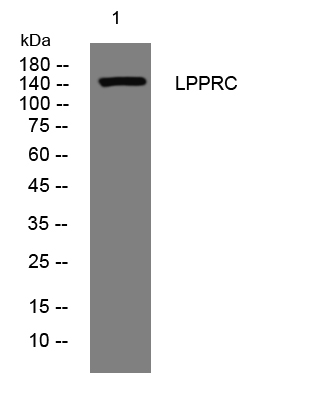LPPRC rabbit pAb
- Catalog No.:YT6371
- Applications:WB;ELISA;IHC
- Reactivity:Human;Mouse;Rat
- Target:
- LPPRC
- Gene Name:
- LRPPRC LRP130
- Protein Name:
- LPPRC
- Human Gene Id:
- 10128
- Human Swiss Prot No:
- P42704
- Mouse Gene Id:
- 72416
- Mouse Swiss Prot No:
- Q6PB66
- Rat Gene Id:
- 313867
- Rat Swiss Prot No:
- Q5SGE0
- Immunogen:
- Synthesized peptide derived from human LPPRC AA range: 1329-1379
- Specificity:
- This antibody detects endogenous levels of LPPRC at Human/Mouse/Rat
- Formulation:
- Liquid in PBS containing 50% glycerol, 0.5% BSA and 0.02% sodium azide.
- Source:
- Polyclonal, Rabbit,IgG
- Dilution:
- WB 1:500-2000;IHC 1:50-300; ELISA 2000-20000
- Purification:
- The antibody was affinity-purified from rabbit antiserum by affinity-chromatography using epitope-specific immunogen.
- Concentration:
- 1 mg/ml
- Storage Stability:
- -15°C to -25°C/1 year(Do not lower than -25°C)
- Molecular Weight(Da):
- 153kD
- Background:
- This gene encodes a leucine-rich protein that has multiple pentatricopeptide repeats (PPR). The precise role of this protein is unknown but studies suggest it may play a role in cytoskeletal organization, vesicular transport, or in transcriptional regulation of both nuclear and mitochondrial genes. The protein localizes primarily to mitochondria and is predicted to have an N-terminal mitochondrial targeting sequence. Mutations in this gene are associated with the French-Canadian type of Leigh syndrome. [provided by RefSeq, Mar 2012],
- Function:
- disease:Defects in LRPPRC are the cause of Leigh syndrome French-Canadian type (LSFC) [MIM:220111]. Leigh syndrome is a severe neurological disorder characterized by bilaterally symmetrical necrotic lesions in subcortical brain regions that is commonly associated with systemic cytochrome c oxidase (COX) deficiency. In the Saguenay-Lac Saint Jean region of Quebec province in Canada, a biochemically distinct form of Leigh syndrome with COX deficiency has been described. Patients have been observed to have a developmental delay, hypotonia, mild facial dysmorphism, chronic well-compensated metabolic acidosis, and high mortality due to episodes of severe acidosis and coma. Enzyme activity was close to normal in kidney and heart, 50% of normal in fibroblasts and skeletal muscle, and nearly absent in brain and liver. LSFC patients show reduced (<30%) levels of LRPPRC in both fibroblast and live
- Subcellular Location:
- Mitochondrion. Nucleus, nucleoplasm. Nucleus inner membrane. Nucleus outer membrane. Seems to be predominantly mitochondrial.
- Expression:
- Expressed ubiquitously. Expression is highest in heart, skeletal muscle, kidney and liver, intermediate in brain, non-mucosal colon, spleen and placenta, and lowest in small intestine, thymus, lung and peripheral blood leukocytes.
- June 19-2018
- WESTERN IMMUNOBLOTTING PROTOCOL
- June 19-2018
- IMMUNOHISTOCHEMISTRY-PARAFFIN PROTOCOL
- June 19-2018
- IMMUNOFLUORESCENCE PROTOCOL
- September 08-2020
- FLOW-CYTOMEYRT-PROTOCOL
- May 20-2022
- Cell-Based ELISA│解您多样本WB检测之困扰
- July 13-2018
- CELL-BASED-ELISA-PROTOCOL-FOR-ACETYL-PROTEIN
- July 13-2018
- CELL-BASED-ELISA-PROTOCOL-FOR-PHOSPHO-PROTEIN
- July 13-2018
- Antibody-FAQs
- Products Images

- Western blot analysis of lysates from Hela cells, primary antibody was diluted at 1:1000, 4°over night

- Immunohistochemical analysis of paraffin-embedded human liver cancer. 1, Antibody was diluted at 1:200(4° overnight). 2, Tris-EDTA,pH9.0 was used for antigen retrieval. 3,Secondary antibody was diluted at 1:200(room temperature, 45min).



